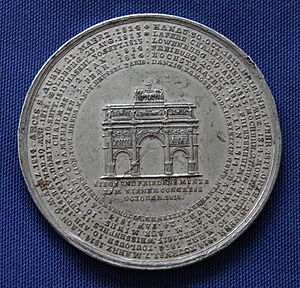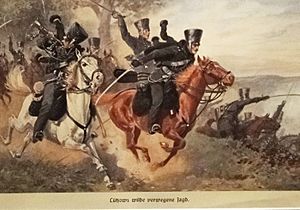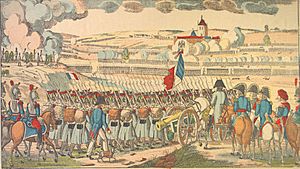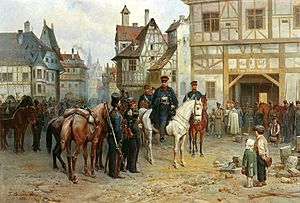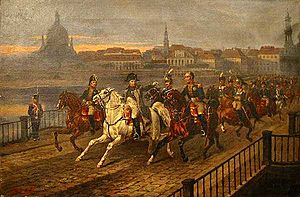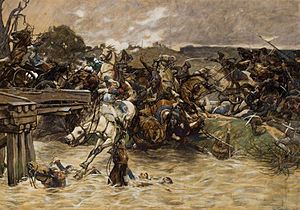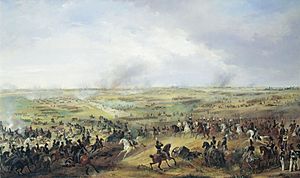German campaign of 1813 facts for kids
Quick facts for kids German campaign |
|||||||||
|---|---|---|---|---|---|---|---|---|---|
| Part of the War of the Sixth Coalition | |||||||||
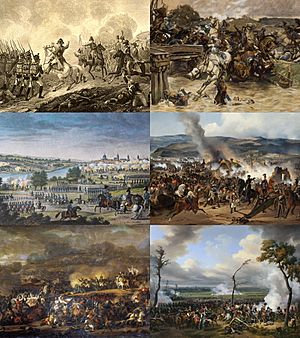 Click an image to load the battle. Left to right, top to bottom: Battles of Lutzen, Katzbach, Dresden, Kulm, Leipzig, Hanau |
|||||||||
|
|||||||||
| Belligerents | |||||||||
German states: |
|
||||||||
| Commanders and leaders | |||||||||
| Strength | |||||||||
|
16 August 1813: 512,113 men 1,380 guns |
16 August 1813: 442,810 men 1,284 guns |
||||||||
| Casualties and losses | |||||||||
|
360,000
|
460,000
|
||||||||
| Casualty statistics are the total losses of 1813. | |||||||||
The German campaign was a series of battles fought in 1813. It was part of the larger War of the Sixth Coalition. In these battles, countries like Austria, Prussia, Russia, and Sweden teamed up. They fought against the French Emperor Napoleon and his allies, including the Confederation of the Rhine. This alliance was made up of many German states.
The campaign aimed to end France's control over Germany. In Germany, this war was known as the Wars of Liberation or Wars of Freedom.
After Napoleon's army, the Grande Armée, suffered a huge defeat in Russia in 1812, things changed. A German general named Johann Yorck made a ceasefire with the Russians. This happened on December 30, 1812, and was called the Convention of Tauroggen. This agreement was a key moment that led to the German campaign starting the next year.
The first part of the campaign in spring 1813 ended without a clear winner. Both sides agreed to a summer break called the Truce of Pläswitz. During this break, leaders from Prussia, Russia, and Sweden met. They created a plan called the Trachenberg Plan to work together against Napoleon.
After the truce, Austria joined the team against Napoleon. This meant Napoleon couldn't make separate deals with Austria and Russia. The anti-Napoleon team now had many more soldiers. Even though they had some tough moments, like the Battle of Dresden, they eventually won. The biggest victory for the allies was the Battle of Leipzig in October 1813. This battle was a major loss for Napoleon.
After this defeat, the Confederation of the Rhine broke apart. Many of its former states then joined the allies. This ended Napoleon's power over Germany. In early 1814, the allies invaded France. Napoleon was forced to give up his power. The war officially ended in May 1814 with the Treaty of Paris.
Contents
Why the German Campaign Started
Since 1806, many writers and thinkers in Germany had been speaking out. People like Johann Philipp Palm and Ernst Moritz Arndt were upset about France controlling much of Germany. They wanted all Germans, including those from Prussia and Austria, to work together. Their goal was to kick the French out.
From 1810, Arndt and another figure, Friedrich Ludwig Jahn, asked Prussian leaders to prepare for a revolt. Jahn even helped create the Lützow Free Corps, a group of volunteers. These people helped start the fighting in Germany. They joined the army and also supported the allies with their writings.
Even before the main German campaign, there were smaller uprisings against French troops. These happened in places like Hesse starting in 1806. In 1809, there was also the Tyrolean Rebellion. These revolts grew stronger under leaders like Wilhelm von Dörnberg and Major Ferdinand von Schill.
How the Campaign Unfolded
After Napoleon's army was almost completely destroyed in Russia in 1812, a big change happened. General Johann Yorck, who led German soldiers fighting for Napoleon, made a ceasefire with the Russians. This agreement, called the Convention of Tauroggen, was signed on December 30, 1812. It was a key event that led to the German campaign in 1813.
On March 17, 1813, Prussia officially declared war on France. This happened when Russian Emperor Alexander I met with King Frederick William III of Prussia. The King then published a speech called An Mein Volk (To My People). In this speech, he called for a war to free Germany.
New Prussian groups like the Landwehr (a type of militia) and Landsturm (a home guard) were formed. Volunteers also joined, including the Lützow Free Corps. Soldiers from Russia, Sweden, and Austria also joined the fight. Great Britain helped by sending money, even though they were busy fighting in other wars.
Prussia's Comeback
The Convention of Tauroggen was a turning point for Prussia. As news spread about Napoleon's army being destroyed, people in Prussia realized how bad the situation was for France. Years of French control had made them eager for freedom. The king and his ministers were worried because they knew how strong France still was.
But the Russian soldiers and the Prussian people were determined to keep fighting. They pressured their leaders to support the troops. They couldn't refuse food and shelter to their own people or their allies. Slowly, French troops scattered across the country found themselves surrounded or had to retreat. Prince Eugène de Beauharnais, who was in charge of Napoleon's forces in the area, had to pull back his troops. He moved from Posen to Magdeburg, where he got more soldiers.
Napoleon's New Army
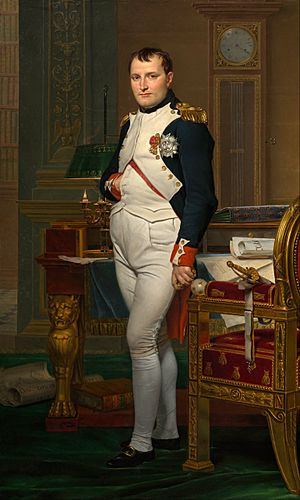
Meanwhile, in Paris, Napoleon was busy building a new army. He wanted to take back Prussia. He hadn't used too many French soldiers yet, as he had relied on his allies to fight for him. He also created a new National Guard in 1811–1812. These were partly trained men who could join the main army.
Napoleon also demanded more soldiers from the states in the Rhine Confederation and even Italy. By the end of March, 200,000 men were moving towards the Elbe River. By mid-April, they were gathered near the Elbe and Saale rivers. From there, they could threaten Berlin or Dresden.
Spring Battles Begin
The allies knew Napoleon was getting stronger. But they only had about 200,000 soldiers ready. They left a small group near Magdeburg to watch for any moves towards Berlin. Most of their forces were near Dresden. Their plan was to march along the Elbe River and attack the French from the right.
Both armies didn't have good information about each other. Neither side had enough cavalry to scout properly. Napoleon was in mostly unfriendly territory, so he had even less information than his enemies.
On April 25, Napoleon arrived in Erfurt and took command. His troops were spread out. They then began moving towards Merseburg and Leipzig. Napoleon used his usual strategy: a strong group of soldiers in front, with the main army following behind.
The Prussians and Russians gathered their forces too. They moved in a similar direction but a bit to the south of the French. On May 1, Napoleon's advance guard entered Lützen. The Russian general, Peter Wittgenstein, thought this was Napoleon's whole army. He decided to attack the French from the right side.
Battle of Lützen
Around 9:00 AM on May 2, Wittgenstein attacked the French advance guard in Lützen. The rest of his army moved towards Napoleon's right and rear. But just as they were moving, the main French army suddenly appeared. At 11:00 AM, Napoleon heard the sound of heavy cannons. He quickly understood what was happening.
Napoleon rushed to the battle and quickly organized his forces. He let his front troops fight off the strong attacks from the Prussians and Russians. He didn't mind if they lost some ground. He quickly put together a group of reserve soldiers. When both sides were tired, he sent almost a hundred cannons forward. These cannons fired into the enemy lines. Then, his reserve troops marched right through the gap they created.
If Napoleon had more cavalry, he would have won a complete victory. But as it was, the allies retreated in good order. The French were too tired to chase them. This battle showed Napoleon's great skill in understanding the battlefield. He knew his new soldiers weren't as experienced as his old ones. He was everywhere, encouraging his men. His strategy worked, even against a surprise attack.
Battle of Bautzen
After Lützen, the French army chased the allies. Napoleon sent Marshal Michel Ney across the Elbe River to attack the allies at Dresden. This forced the allies to leave Dresden and cross the Elbe, blowing up the stone bridge behind them. Napoleon entered the town right after them. But the broken bridge caused a four-day delay because the French didn't have pontoon bridges.
On May 18, the French continued their march. But the allies had retreated slowly, gathering more soldiers along the way. They set up a strong, fortified position near Bautzen. On May 20, Napoleon attacked them. After a two-day battle, he forced them to move. However, the French cavalry was weak, which limited how effective the attack was. It also meant Napoleon didn't get many prisoners or captured cannons.
The allies managed to retreat in good order. Napoleon was very annoyed that they escaped without losing much. He pushed his commanders to chase them harder. This led to some French divisions being careless. At the Battle of Haynau on May 26, General Gebhard Leberecht von Blücher used his cavalry to surprise and almost destroy a French division. This didn't cause huge losses for the French, but it greatly boosted the confidence of the new Prussian cavalry.
Hamburg's Occupation
Meanwhile, on May 19, 1813, Swedish troops occupied Hamburg. This happened after Denmark said they would hold the city for Napoleon, which tied Denmark closely to France. The allies were happy about Hamburg being taken, as it was a rich financial center. This was a blow to Napoleon.
However, the Swedish commander, Bernadotte, was worried about his troops being so far from the main allied lines. His worries proved right when Marshal Davout approached Hamburg with a large French force of 35,000 men. The Swedes quietly left on May 26. Davout then occupied Hamburg until Napoleon gave up his power in 1814. This was the last major action before the Armistice of Pläswitz.
Summer Break: The Truce of Pläswitz
The allies kept retreating, and the French couldn't force them into another big battle. Napoleon was worried about Austria possibly joining his enemies. He also saw his supply lines getting longer and more difficult. So, he started talking about a ceasefire. The allies, who had everything to gain, agreed to a six-week break in fighting. This was called the Truce of Pläswitz. Many historians believe this was a big mistake for Napoleon.
During this truce, three allied leaders met: Emperor Alexander of Russia, King Frederick William of Prussia, and Crown Prince Bernadotte of Sweden. They met at Trachenberg Castle to plan their next moves. Bernadotte, who used to be a French general under Napoleon, used his knowledge to help create the Trachenberg Plan.
This plan was to wear down the French army. The allies would avoid direct battles with Napoleon himself. Instead, they would try to fight and defeat his marshals (his top generals) whenever possible. They would slowly surround the French with three separate armies. Their goal was to trap Napoleon and force him into a battle against a much larger force.
After the meeting, the allies formed three main armies:
- The Army of Silesia: 95,000 Prussians and Russians, led by Field Marshal Gebhard von Blücher.
- The Army of the North: 135,000 Swedes, Russians, Prussians, and German troops, led by Sweden's Crown Prince Bernadotte.
- The main Allied force: 225,000 Austrians and Russians, led by Prince Karl von Schwarzenberg. The leaders of Russia, Austria, and Prussia oversaw this army.
Autumn Battles Begin
Once the ceasefire ended on August 15, Napoleon quickly moved his troops. He knew Austria was now an enemy. He decided to gather his forces around Gölitz and Bautzen. From there, they could either meet the enemy coming from Breslau or attack them from the side if they tried to enter Saxony.
This plan depended on him holding Dresden. So, he sent troops to Pirna and Königstein to protect Dresden's defenses. Napoleon planned to defend the Elbe River line. He would only make quick attacks lasting a few days if the enemy presented a good target.
More soldiers kept arriving for Napoleon. By early August, he thought he would have 300,000 men near Bautzen. He also had 100,000 men along the Elbe River, from Hamburg to Torgau. He decided to strike first with these 100,000 men by marching on Berlin. He believed this would have a huge impact.
As the truce ended, Napoleon learned where the allied armies were. Crown Prince Charles John (Bernadotte) had 135,000 men near Berlin and Stettin. Blücher had about 95,000 Russians and Prussians near Breslau. Schwarzenberg had nearly 180,000 Austrians and Russians in Bohemia. Napoleon felt confident in his position at Bautzen.
Battle of Dresden
The march towards Berlin started right when the truce ended. However, Napoleon, leading the main French army, waited to see what his enemies would do. He eventually became impatient and moved some of his army towards Blücher. Blücher fell back, trying to lure Napoleon into a trap.
Then, Napoleon heard that Schwarzenberg was moving down the Elbe valley. He left Macdonald to watch Blücher and rushed back to Bautzen. He planned to move his troops over the Bohemian mountains towards Königstein. This move could have been decisive. But news from Dresden was so alarming that he changed his mind at the last minute.
He sent only General Vandamme over the mountains. Napoleon himself rushed with his entire army to Dresden. This march was amazing: most of his forces moved about 90 miles in 72 hours. They entered Dresden on the morning of August 27, just hours before the allies attacked.
Dresden was Napoleon's last great victory. By noon on August 27, the Austrians and Russians were completely defeated and retreating. The French chased them closely. But then, Napoleon seemed to lose focus. He didn't give clear orders for the chase. He rode back to Dresden, leaving his generals to figure out the next steps.
French Losses
The allies continued to retreat. Unfortunately for the French, Vandamme, with his single army corps, came out of the mountains on their side. He tried to block their retreat near Kulm. But he was completely overwhelmed by the sheer number of allied soldiers at the Battle of Kulm on August 29.
Despite this setback, Napoleon could still claim a victory at Dresden. But almost at the same time, he received bad news. General Oudinot had been badly defeated at the Battle of Grossbeeren near Berlin on August 23 by Bernadotte. And Macdonald had been defeated at the Battle of Katzbach on August 26 by Blücher.
Napoleon's Next Moves
For the next two days, Napoleon thought about his situation. He wrote down plans that have confused military thinkers ever since. He seemed to forget his usual military rules. He considered plans based on guesses, not facts, and focused on places rather than the enemy's army.
He was finally shaken out of his thoughts by news that Macdonald's defeat had badly hurt his army's morale. Napoleon immediately went to fix things. His anger and behavior were so extreme that his aide, Caulaincourt, had trouble hiding the scandal.
Blücher, hearing of Napoleon's arrival, immediately retreated. Napoleon followed him. This left the passes over the Bohemian mountains open. Schwarzenberg quickly took advantage of this. When Napoleon learned of Schwarzenberg's approach, he again pulled back to Bautzen.
Then, hearing that the Austrians were moving back towards Dresden, Napoleon rushed there again. He gathered as many men as he could and advanced beyond Pirna and Königstein to meet them. But the Austrians didn't plan to attack him. Time was on their side. Napoleon left his men to suffer from lack of food in the area and returned to Dresden. He stayed there for the rest of the month, seeming very unsure of what to do. On October 4, he again reviewed the situation. He seemed to consider cutting off his communication with France and staying in Dresden for the winter. Yet, he knew his men were suffering from hunger.
The Leipzig Campaign
Meanwhile, Blücher, Schwarzenberg, and Bernadotte were moving around Napoleon's sides. Ney, who had joined Oudinot after Grossbeeren, was defeated at the Battle of Dennewitz on September 6 by Bernadotte's Army of the North. Prussian troops did most of the fighting until Swedish and Russian troops arrived and routed the French.
Suddenly, Napoleon's plans changed completely. He called up General St Cyr, who he had told to stay in Dresden. Napoleon decided to fall back towards Erfurt. He planned to spend the winter between Erfurt and Magdeburg. He pointed out that Dresden was not a good base for him. He thought it was better to have St Cyr and his men with him for a battle.
On October 7, Napoleon made a final plan. This plan showed his old military genius. He immediately started to carry it out. He knew the danger to his retreat route from Blücher, Schwarzenberg, and the North Army. Yet, only a few hours later, he changed his mind about St Cyr and another general, Lobau. He left them behind in Dresden.
From October 10 to 13, Napoleon stayed in Düben, again very unsure of what to do. But on October 13, he thought he saw an opportunity. Blücher was reported near Wittenberg, and Schwarzenberg was slowly moving south of Leipzig. The North Army under Bernadotte was near Halle, but Napoleon didn't know this.
Napoleon decided to send most of his force against Blücher. After defeating him, he would turn south to Schwarzenberg and cut off his supplies. He gathered his troops very quickly and surely. But while the French moved towards Wittenberg, Blücher was marching to his right. He didn't worry about his supplies because all of Prussia was behind him.
This move on October 14 brought Blücher into contact with Bernadotte. Now, if all three allied armies had marched forward, Napoleon would have been completely cut off from France. But Bernadotte lost his nerve. When he heard about Napoleon's threat against Wittenberg, he decided to retreat north. Even Blücher and Gneisenau couldn't convince him to stay. So, while Napoleon's move didn't directly hit the enemy, it indirectly helped him survive for a little longer.
The Battle of the Nations
On October 15, Napoleon gathered his forces east of Leipzig. He had only a small group of soldiers to the west. By evening, the allies were ready to attack him. Schwarzenberg had 180,000 men ready, and another 60,000 would arrive the next day. Blücher had about 60,000 men. But Bernadotte wouldn't arrive until October 18.
Napoleon planned to send most of his force against Schwarzenberg. He gathered his troops southeast of the town. Schwarzenberg marched towards him, with most of his troops on the right bank of the Pleisse River. A strong column under Giulay moved on the left to join Blücher in the north. The fighting was very tough, but the Austrians couldn't break the French lines. Giulay even had to pull back.
On the other hand, Blücher captured the village of Möckern and got very close to the town gates. On October 17, there was only minor fighting. Schwarzenberg waited for more soldiers coming from Dresden. Blücher waited for Bernadotte to join him on his left. By a strange mistake, Giulay was moved closer to the Austrian center. This opened up the French escape route towards Erfurt. Blücher wasn't told about this move. When Napoleon realized what happened, he sent troops to Lindenau to keep the road open.
On October 18, the fighting started again. Around noon, Bernadotte arrived and closed the gap northeast of the town between Blücher and the Austrians. At 2:00 PM, the Saxons, who had been loyal to Napoleon longer than his other German allies, switched sides. They joined Bernadotte's Army of the North. Bernadotte had issued a message a week earlier, asking the Saxons to rejoin him (he had commanded them before).
All hope of winning the battle was now lost for Napoleon. But the French fought hard to cover their retreat. By daybreak the next morning, half of the army was already leaving along the road to Erfurt. This road had luckily been left open for them.
French Retreat and Battle of Hanau
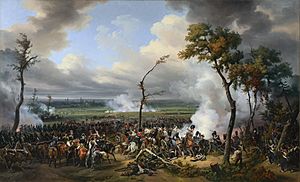
It took Blücher some time to get his troops organized after the battle. The French soldiers left in Leipzig and on the right bank of the Elster River still fought bravely. So, the allies couldn't start a direct chase right away. The French, still over 100,000 strong, marched quickly and gained enough distance to regroup.
Blücher followed on their northern side, using smaller roads. But Schwarzenberg knew that the Bavarians had also left Napoleon. They were marching under General Karl Philipp von Wrede to block Napoleon's retreat. So, Schwarzenberg followed very slowly. Blücher didn't catch up to the French. However, near Hanau, the French found their way blocked by Wrede. He had 40,000 men and over 100 cannons in a strong position.
Napoleon and his army responded to this new challenge with great bravery. Just like in Russia in 1812, Napoleon ordered his troops to attack the enemy directly. After some clever artillery moves, the French marched right over Wrede's forces. They almost completely destroyed his army, but they also suffered heavy losses themselves. After this, their march was not bothered. The French reached Mainz on November 5, ready to prepare for the invasion of eastern France.
What Happened Next
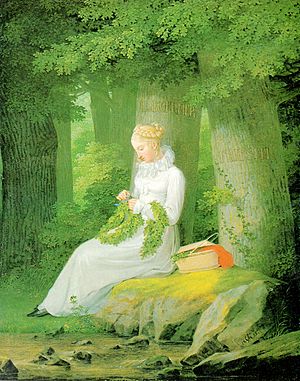
When the last French troops crossed the Rhine River back into France, the allied leaders disagreed on what to do next. Everyone was tired of the war. Many felt it would be unwise to push Napoleon and the French people too hard. So, there was a long pause. The troops used this time to get new equipment.
But eventually, the "Young German" group, led by Blücher and other strong military leaders, won the argument. In early 1814, the allies invaded France. At the same time, Field Marshal Arthur Wellesley, the Duke of Wellington invaded France from the Pyrenees in the south.
Napoleon fought a campaign in northeastern France, but he lost. This led to Paris being taken over, Napoleon giving up his power, and being sent away to Elba. The old French monarchy was brought back under King Louis XVIII.
The German campaign ended the period of French control in Germany. It also helped create a new feeling of German unity and national pride. Sweden stopped being involved in German affairs after 175 years. Sweden gave up Swedish Pomerania to Prussia in exchange for Prussia recognizing the Treaty of Kiel (which included Sweden and Norway joining together) and £500,000.
The German Confederation, formed in 1815, was a step towards the modern German nation. However, this nation was only fully formed much later under Prussian leadership, without Austria. The memory of the campaign in Germany was shaped by the soldiers who fought, especially the many students who volunteered. A new wave of remembering the war happened in 1913, on its 100th anniversary.
See also
- Napoleonic Wars
- Treaty of Kiel
- War of the Sixth Coalition
- Wars and battles involving Prussia


